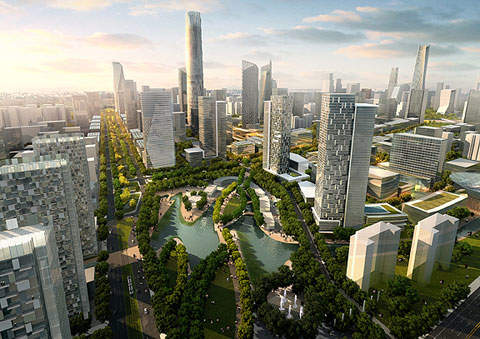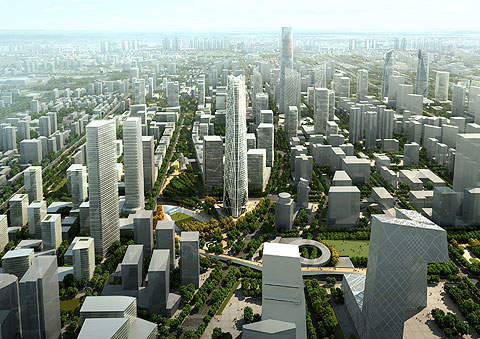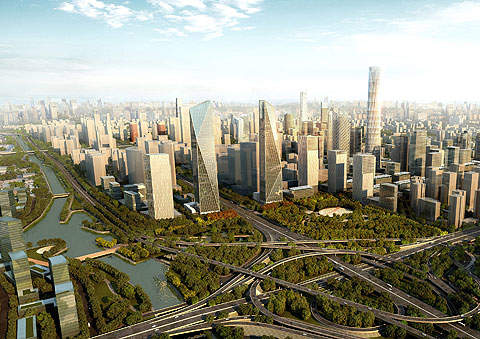The Beijing Chaoyang District Planning Bureau is about to redevelop the Dawangjing district in Beijing, the capital city of China. The master plan for what is known as the Dawangjing Central Business District has been designed by the leading international architecture firm Skidmore, Owings & Merrill (SOM). The redevelopment will serve as a demonstrative example of integrating environmental conservation techniques and the principles of urban planning, design and architecture.
The master plan was selected through an international competition held in 2010. The District Planning Bureau conducted the competition, seeking a design that would strongly reflect the local culture and simultaneously develop the region as a major commercial centre. The winning design was made jointly by the Chicago and China offices of SOM.
The Dawangjing district is a gateway to reach Beijing. The redevelopment is aimed at attracting tourists as well as reducing carbon emissions.
Dawangjing district master plan
The proposed redevelopment of Dawangjing is located 11km from Beijing Capital International Airport. Major space in the Dawangjing district is occupied by residential developments. The master plan proposed by SOM has, therefore, laid emphasis on creating a mixed use development plan for the district.
Since Dawangjing has been aimed to serve as a gateway to Beijing, SOM planned for a number of high-rise structures in the redevelopment. The high-rise buildings will attract offices to the district and will also serve as premium residential towers. The master plan further accommodates up to 1.5 million square metres of development to be added in future as the district’s economy grows.
Transportation facilities have been given due importance in the redevelopment. The master plan aims to achieve 80% of commuter journeys in the district to be made either by public transit or non-polluting modes such as walking and bicycles.
A big park, known as Central Park, will be developed to mitigate environmental pollution.
Dawangjing district redevelopment design
Peter Ruggiero and Philip Enquist were the lead architects of SOM’s team, who designed the master plan. Peter Ruggiero is design partner at SOM, while Philip Enquist is the company’s partner-in-charge of urban design and planning. The team received collaborative support from Beijing R&F Properties Development, E-House (China) Holdings and MVA Transport Consultants.
Traffic and emission-reducing facilities
The avoidance of traffic congestion and pollution has been given due importance in the master plan. In order to achieve this, a network of bicycle lanes will be created to reduce congestion and encourage the use of non-motorised vehicles. It will reduce automobile traffic and, thereby, pollution.
The plan also proposes to set up transit stations on the M15 subway line in order to facilitate transportation between the district and Beijing Capital International Airport. There is also a provision for setting up a streetcar network to link the district with other districts in Beijing.
A number of public parks are planned to be developed. Cultural venues will be built to showcase the local culture to tourists.
Beijing district master plan construction
The Beijing Chaoyang District Planning Bureau will develop the district master plan in phases in the coming years. A detailed time schedule for construction is yet to be announced.
SOM sustainable master plan development
SOM’s emphasis on sustainable development in its design of the master plan for Dawangjing will result in a reduced carbon footprint and the protection of natural resources in the region. The passive design will reduce the need for mechanical cooling or heating devices, which consume water and electricity.
The Central Park will be involved in achieving temperature control in the district by heating and cooling buildings as required. The park will act as a geo-thermal exchange, according to SOM. The proposed green facility will also reduce the need for cooling towers and, thus, the consumption of water by these machines.
The Dawangjing redevelopment is, therefore, intended to have a positive environmental impact on the region.










